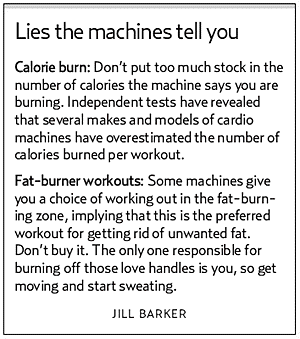|
Be heart smart at the gym
by Jill Barker
The Gazette, Tuesday, January 27, 2009
INDOOR CARDIO WORKOUTS require some extra steps to meet the benefits of an outdoor regime. Start by turning off the phone |
 RICHARD ARLESS JR. GAZETTE FILE PHOTO
RICHARD ARLESS JR. GAZETTE FILE PHOTO |
| Reading a book on a cardio macine can have a negative impact on workout intensity.
|
If the recent bout of frigid weather has chased you indoors, you may find yourself working out in unfamiliar territory. Getting your cardio in the gym – as opposed to outside – takes a bit more savvy than knowing when to pull on the long johns.
Before you look around to see what everyone else is doing, keep in mind that there are plenty of newbies in the gym at this time of year, most of whom aren’t the best role models. That being said, it’s not always wise to rely on the sage advice of gym veterans either, as even they aren’t immune to bad technique or funky training practices.
To help get you on the right track, here are some tips for anyone and everyone who hits the cardio machines at the gym.
For those who prefer weight training, take a look at this space in two weeks for tips on working out in the weight room.
Don’t multi-task
While it may be physically possible to read a book, talk on the phone or study for an exam while working out on most cardio machines, multi-tasking in the gym isn’t the best idea. A good workout demands concentration, as does a good book or a good friend at the other end of the phone. So it only stands to reason that paying attention to one will distract from the other. That distraction often has a negative effect on workout intensity and exercise technique, and in some cases can even lead to injury – especially if you become more enthralled in the diversion than the task at hand.
If you need some form of extrinsic motivation while working out, stick to your MP3 player. Unlike reading or watching TV, both of which reduce the intensity of your workout, listening to music actually pumps you up and helps you exercise harder and longer.
Watch your posture
It’s amazing how many people lack good postural alignment while working out. Hunching over the console, leaning on the handrails and looking down at the feet are all common faults. Whether you’re on the treadmill, stair stepper, stationary bike or elliptical machine, keep the upper body tall, the shoulders down and the head in line with the spine. Centre your body weight over your feet (when using machines where you stand) and don’t use your hands or forearms for additional support.
As you become fatigued, your posture tends to decline, so either cue yourself to stand taller during the latter stages of your workout or quit before you’re too tired to maintain good form.
Use the interval program
If you ignore the training programs on your cardio machine, you’re missing one of the best features of exercising indoors. And while the myriad of choices can be intimidating, you can’t go wrong choosing the interval program, a staple on most machines.
Why an interval program? One of the most efficient ways to work out, intervals rev up intensity for a minute or so and then slow down and recover for about twice the length of the speed interval. It’s challenging, burns more calories than a steady-state workout of the same length, and for those who are trading a 60-minute outdoor workout for 30 minutes on the treadmill (the standard length of time for which you are allowed to book a cardio machine), the added intensity makes up for the shorter time frame.
Raise the resistance
As much as they try, indoor workouts can’t match the natural challenges that the wind and hills bring to outdoor workouts. Raise the incline on the treadmill to two per cent and dial up the resistance on the bike and elliptical just a bit higher, to simulate the extra effort it takes to train outdoors.
 |
Make the bike fit
If you prefer a stationary bike over any other cardio machine, take the time to adjust it to suit your frame. The first order of business is the seat. Climb on the bike and position the pedals at six and 12 o’clock. Adjust the seat height so that the extended leg is slightly bent when the pedal is at the six o’clock position. Positioned correctly, your hips shouldn’t rock from side to side as you pedal and your leg should never be fully extended when it reaches the bottom of the stroke cycle.
As for the height of the handlebars relative to the seat, your body weight should be evenly distributed over the seat and handlebars. Handlebars that are too high force the butt to support the brunt of the body weight. Too low, and the hands and wrists feel the strain of carrying the load. Adjust the handlebar height until you find your comfort zone.
Some bikes allow you to move the seat forward or backward, which adjusts how far away you are from the handlebars. The ideal position is one in which you don’t have to stretch to reach the handlebars or feel cramped into too tight a position. Your elbows should be slightly bent, with your upper body comfortably stretched forward.
© The Gazette
|



